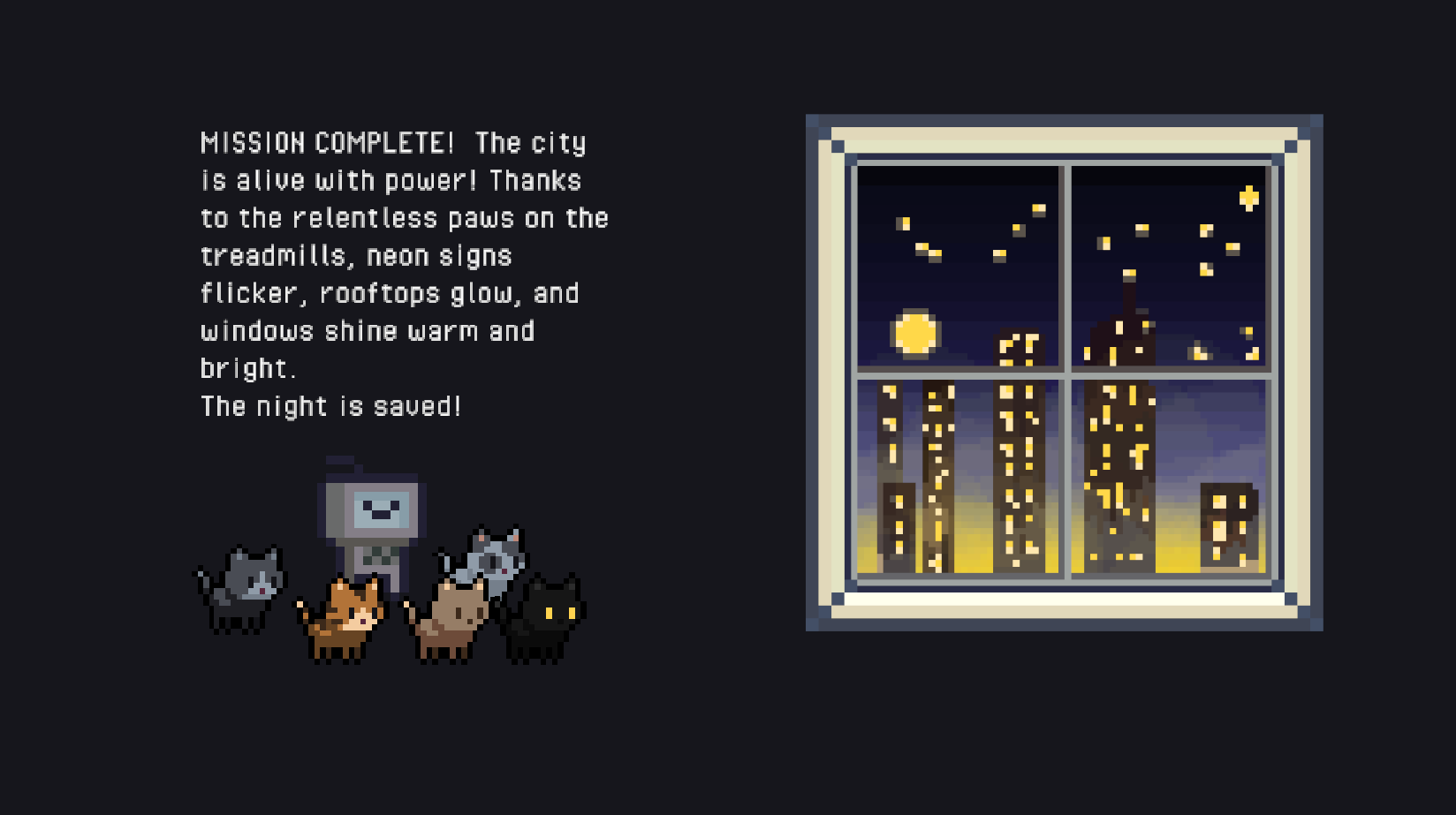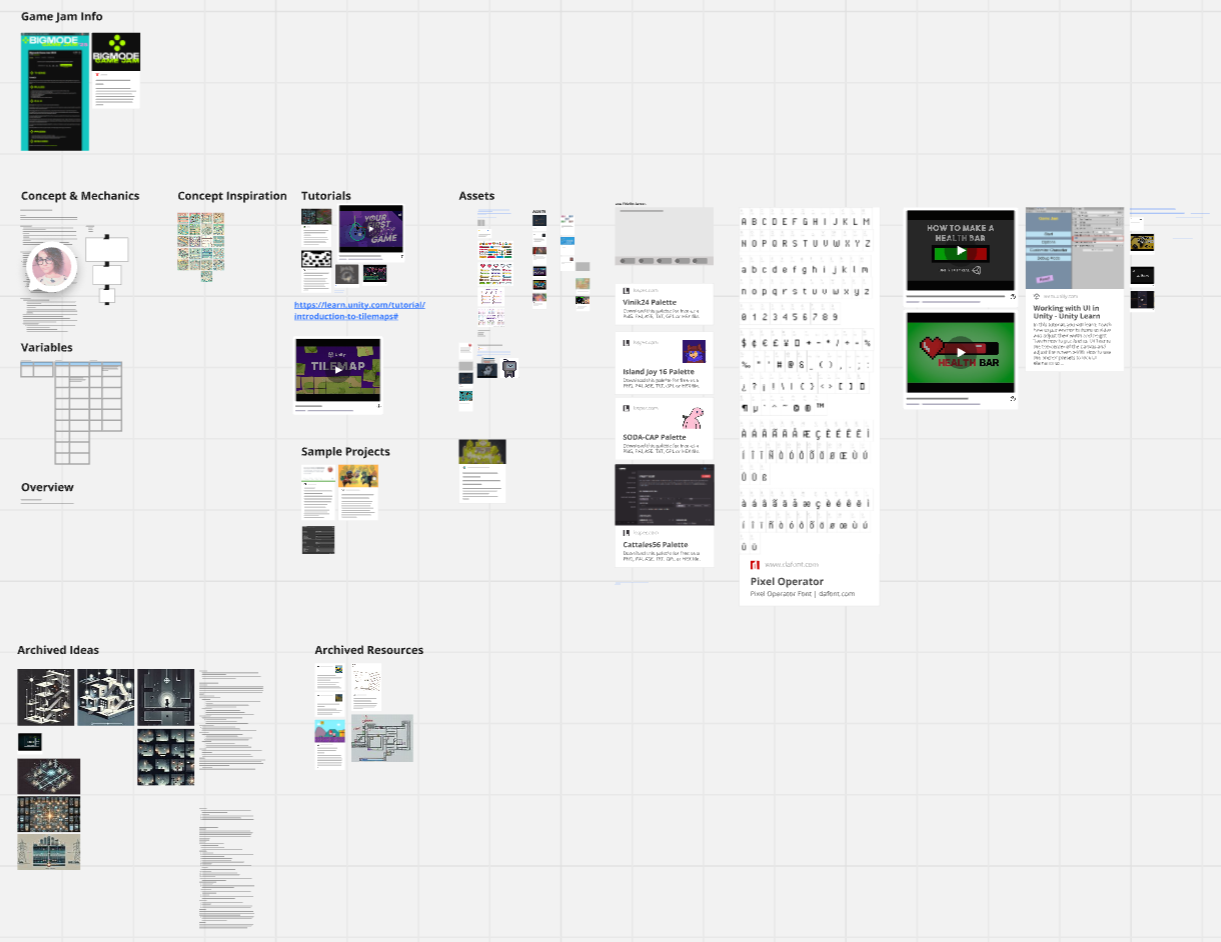Background
Cats on Treadmills is a lighthearted resource management game where players must herd mischievous cats onto treadmills to generate power. Leaning into this theme of chaotic energy management, Cats on Treadmills is a fun blend of strategy and unpredictability. The game was created in one week for Bigmode Game Jam 2025, and centered around its theme of “Power”.
The short timeframe provided an exciting challenge to learn and apply game development knowledge without prior professional experience in the field.
Tools
Unity, VS Code, Miro, itch.io
Role
Game Developer
Project Timeframe
1 week
Team
Kevin Liu, Nivin Nabeel
Concept & Design Process
Initial Goals & Motivations
- Learn Unity game development from scratch in one week.
- Experiment with character behaviors, coding, pixel art, and resource management mechanics.
- Create a fun and chaotic experience that any player can pick up and enjoy.
Initial Idea
The idea for Cats on Treadmills stemmed from the concept of converting cat energy into power, which we thought would be a humorous gameplay mechanic. Some initial inspirations came from:
- Resource management games (e.g. Overcooked) that require balancing multiple needs.
- Animal-based chaos (e.g. Untitled Goose Game) for humorous and eccentric interactions.
- Mobile game design that features simpler controls for broader appeal among players.
Ideas were tracked on a shared Miro board, which served as a mood board and concept inspiration.
Core Mechanics
The game requires the player to manage multiple cat needs while ensuring they run on treadmills to generate power. The mechanics include:
Player control
The player is a character in the game that can physically move and interact with cats.

Cats with individual needs and personalities
Sleep, food, and play must be managed to keep them active.

Treadmill power
Cats generate energy only when placed on treadmills. The energy slowly drains if no cats are running.
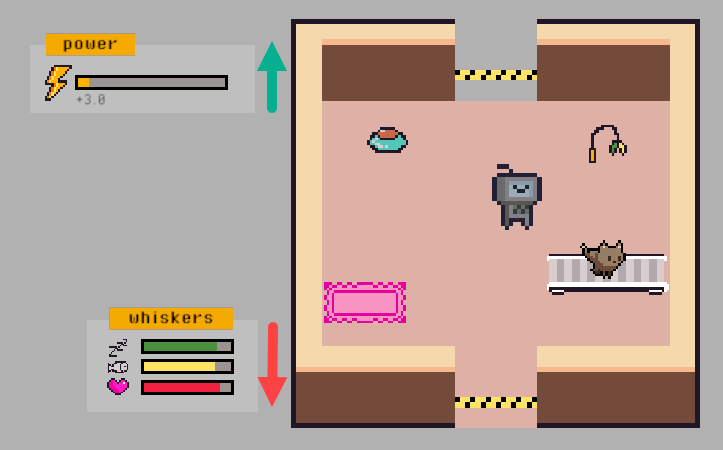
Level progression
The level will complete once a certain power threshold is reached, which would get progressively harder as the game goes on.

Other Design Considerations
- Balancing player agency vs. cat chaos – give players control to interact with the environment, while letting the cats behave unpredictably as they often do.
- Accessible mechanics – easy to learn but challenging to master, which rewards understanding deeper game mechanics.
- Scope control – avoiding feature creep to keep development feasible in a week.
Technical Implementation
Game Engine & Tools
- Engine: Unity
- Programming Language: C#
- Art Assets: Paid and Creative Commons assets from Itch.io and OpenGameArt.org
- Audio Assets: Creative Commons background music from Pixabay
Programming frameworks
Various systems had to be created to house the game’s logic. These systems had to house all of the data, values, and triggers to control the characters, props, and level progression.
Cat framework
Implementing a scalable Cat AI framework that handles cat animations, variable stats, and behaviors. Cats were given various values for their behavior, which help differentiate and make each feel unique.
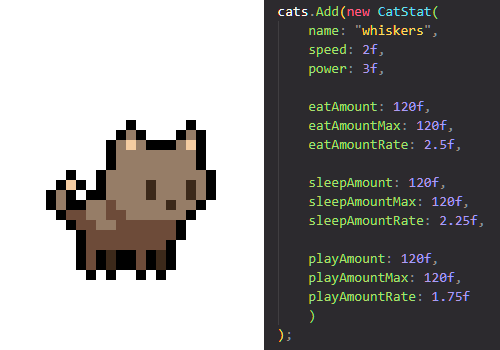
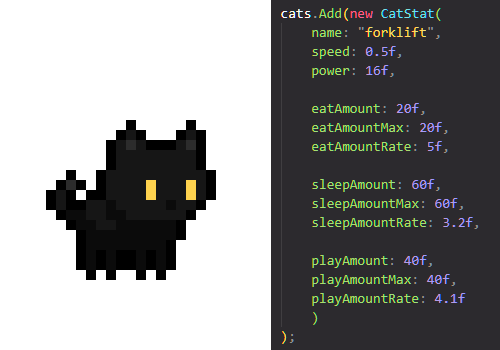
Animation framework
Cat animations where then assigned into a Sprite Library Editor that was labeled according to the frame counter. This way, different cats can be reassigned different animations using the same code variable.
Split between 5 cats, each cat had 9 animations. This equaled to 45 total animation states, and 290 total animation frames!

Logic framework
The various scripting files were set up in a logical way to control the various requirements of the game.
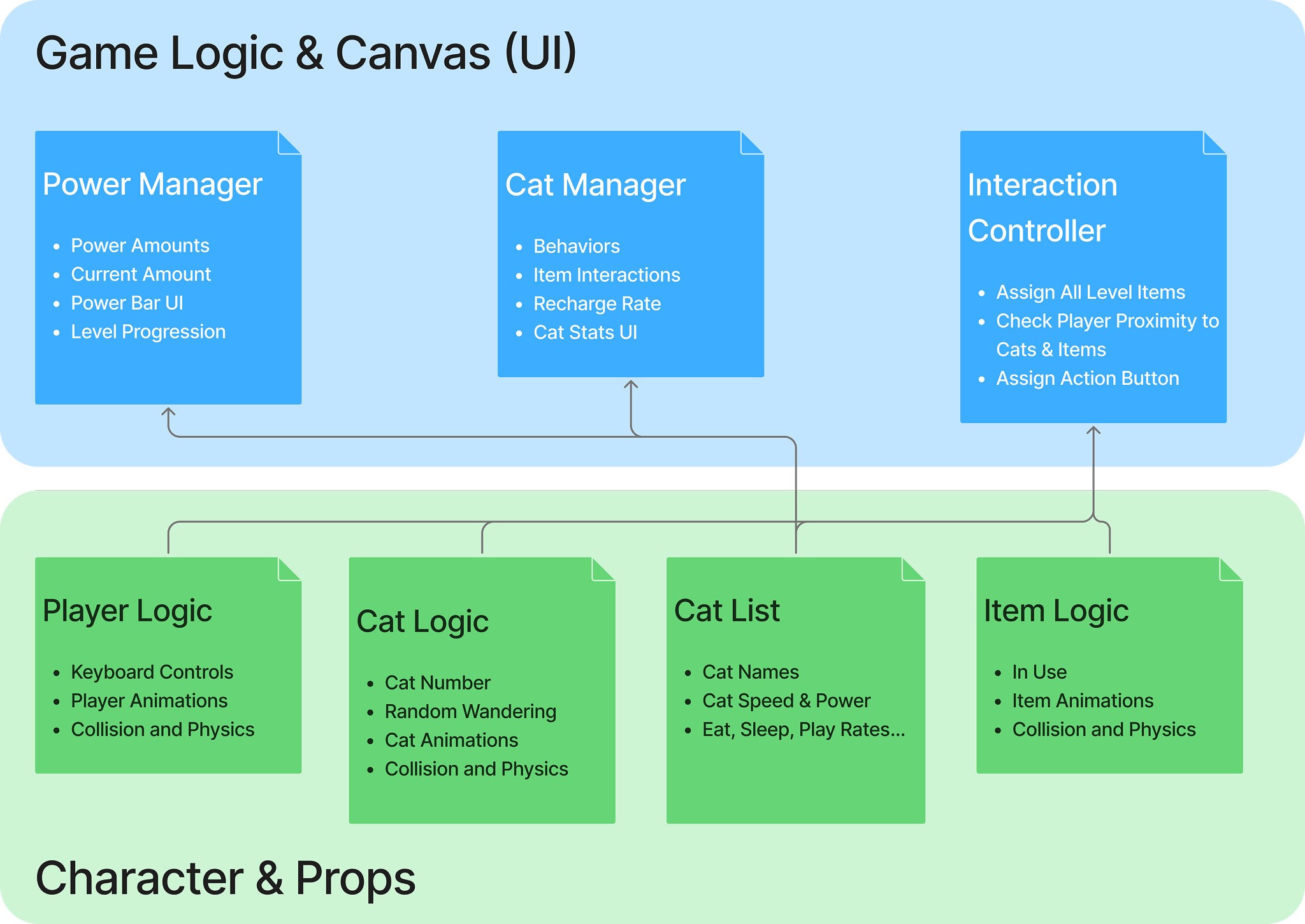
Art, Animation, and Audio
- Cute pixel art assets were handpicked to reflect exaggerated cat and player personalities.
- Level design tilemaps were hand-drawn and custom crafted to fit each level.
- Background music sourced from Pixabay to match the quirky theme.
Development Challenges & Learnings
Major Hurdles
- Learning Unity & C# from scratch – required rapid learning, troubleshooting, and creative solutions up until the last minute.
- Playtesting and compiling – fine-tuning cat and level behaviors to feel dynamic, fun, and not frustrating.
- Scope management – balancing feature ambitions with realistic time constraints. A lot of features had to be cut out as nice-to-haves in order to fit the time we had.
- Version control – this was something that had to be left out but would have been a big time-saver.
Team Dynamics
- Splitting the work – since one person could only be in one file at the same time, work was split based on sub-discipline (e.g. level design, character logic, asset sourcing, interaction coding)
- Design thinking & problem solving – The framework of empathize, define, ideate, prototype, test utilized frequently to refine and build out the mechanics quickly.
Scope & Time Management
What worked
- Prioritizing a functional core loop or mechanic before adding polish
- Making sure the game had a beginning, middle, and end to properly scope the game for the player.
What could be improved
- More planning for game feel and level progression.
- More understanding of compiling requirements
- Better understanding of screen size scaling
Post-Jam Reflection & Impact
Reception & Feedback
- Overall reception was positive and supportive, and had fun exploring the idea of forced cat labor.
- Players really enjoyed the humor behind the mechanics and some grew quite attached to certain cats.
- Some players wanted more levels and varied cat personalities.
- Some players felt the game was too easy.
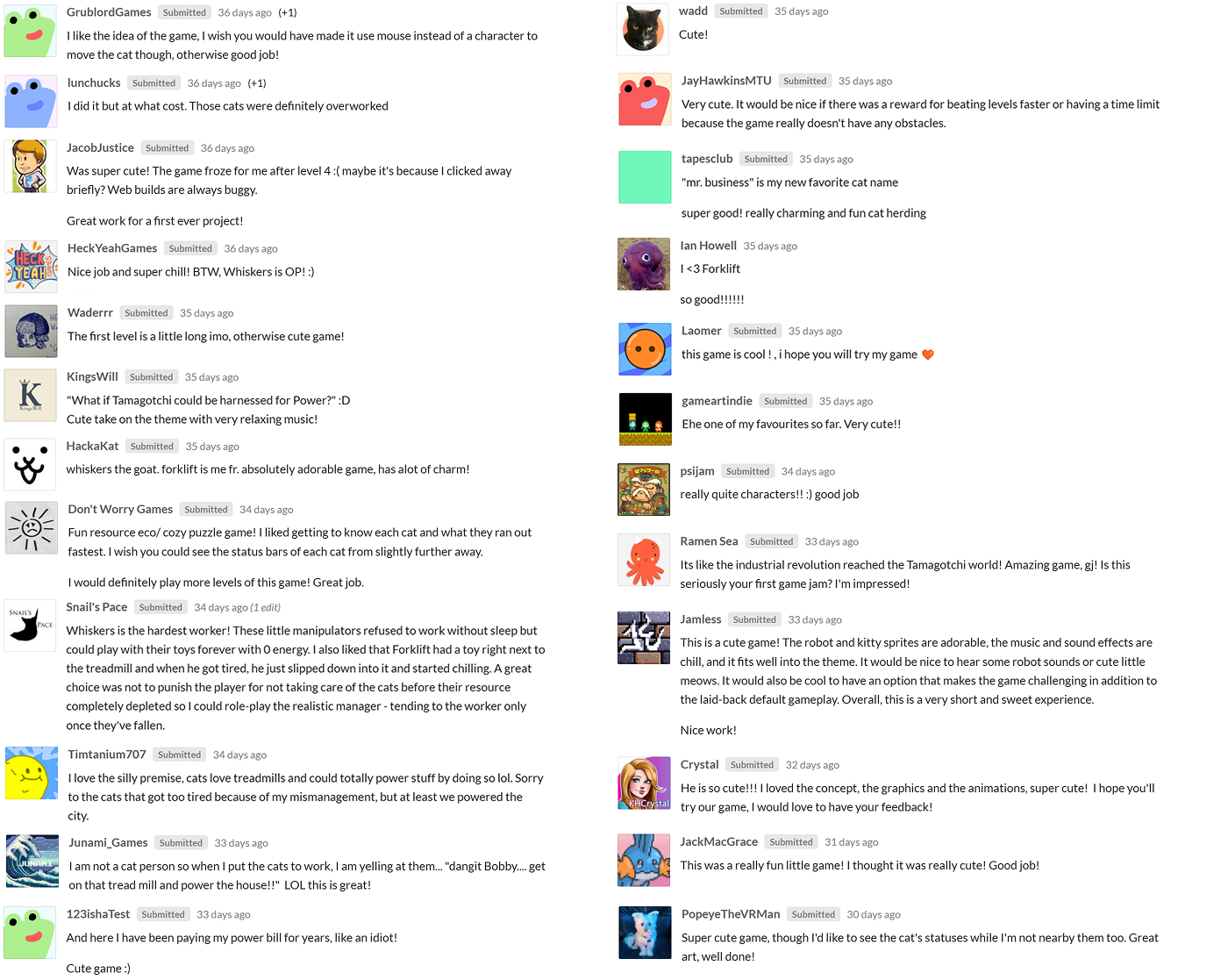
Lessons for the Future
- Have a better grasp of compiling for various screen sizes.
- Tackle version control early to accelerate collaboration.
- More playtesting early to help refine balancing and game feel.
Next Steps
- Potentially refine mechanics and release an updated version with many fixes and updates.
- Explore additional challenges and cat behaviors to increase depth and replayability.
- Continue learning Unity and game development to bring bigger ideas to life.
